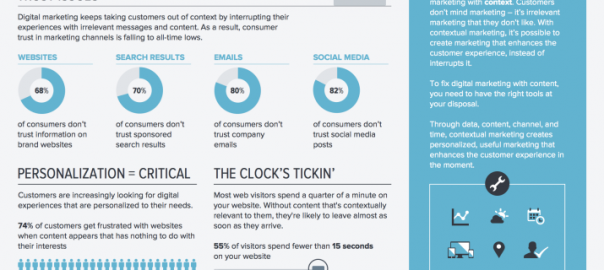On average, how many banner ads do you see a month? Or a day? What about sponsored search results or emails from brands?
If you’re like most people, you probably don’t know. Worse, you probably can’t even remember them. Digital marketing is broken. Marketers keep pushing the same messages through the same channels using the same tactics, but there are some serious trust issues happening.
Digital marketing campaigns today are constantly taking customers out of context. Customers are doing something online and, suddenly, a video trailer plays in front of a YouTube video or a full-scale pop-up ad expands over a blog post. This hasn’t just resulted in banner blindness, it’s resulted in email blindness, video ad blindness, and more. Customers have become accustomed to ignoring any kind of digital marketing campaign they come across – whether it’s on a website, in the inbox, or on Facebook.
This is because so many digital campaigns today are disrupting the customer experience, instead of enhancing it. Rather than focusing on what the customer needs at that moment, brands are focused on how to get their message in front of as many people as possible.
We put together an infographic just provide a snapshot of how badly this is affecting different channels, from paid social campaigns to banner ads and web visits:
Contextual Marketing: Utility & Experience
Instead of repeating the same broken tactics, marketers should think about how to create marketing around each customer’s individual context. Contextual marketing is the art of creating highly relevant, personalized marketing campaigns. By creating content that creates customer experiences instead of disrupting them, brands can actually create marketing offers that customers want to see.
Think about Uber – every time customers click the app, they’re opting into a marketing campaign. They’re looking for the nearest product and the product comes to them. But since it’s useful, customers don’t think of this experience as related to marketing, because the product is exactly what they need, where they need it, at exactly the right time.
Your brand might not be Uber, but that doesn’t mean you can’t create contextual marketing experiences for your customers. This doesn’t take any heavy-lifting when it comes to data or integrated systems, either. You can effectively create contextual marketing within your email campaigns.
Want to find out how? Download our eBook, “Everything You Ever Wanted to Know About Contextual Marketing.”
(271)






